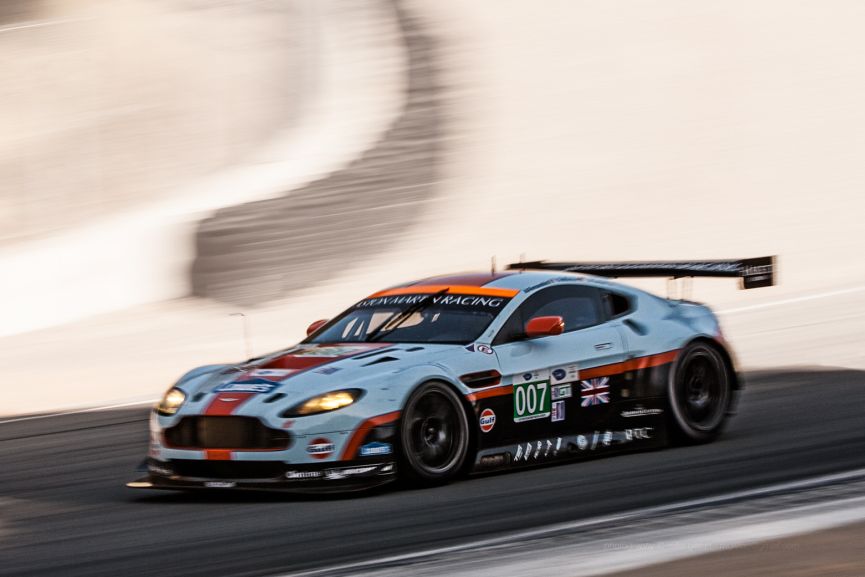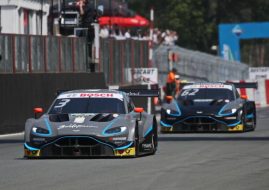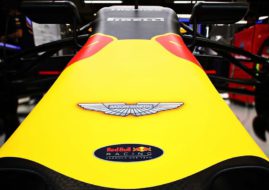Aston Martin Racing - luxury converted into racing excellence
The British car manufacturer Aston Martin has an interesting motorsport history, including a sensational 1-2 overall victory at the 1959 24 hours of Le Mans and devastating two seasons in Formula One (1959-1960). After leaving F1, in the next decades, Aston Martin was mostly known as a manufacturer of luxury sports cars and a supplier of cars for the most famous fictional secret agent James Bond 007. In 2004, the Aston Martin Racing team was founded to revive the glorious moments from the marque’s racing history.
Aston Martin Racing was established as a partnership between Aston Martin and engineering group Prodrive, owned by David Richards. In 2007, Richards also became one of the owners of the Aston Martin, so he had parallel roles as a sporting leader and business leader of the British firm.

David Richards was the man behind Aston Martin’s return to the world’s racing scene
The first Aston Martin Racing car was DBR9
The first racing car of the new team was the DBR9, a heavily modified variant of the Aston Martin DB9. All the cars were built by Prodrive at their factory, but of course, the base was the Aston Martin’s road car. The car’s name is derived from the original DBR1 car, which won Le Mans and the worlds sportscar title in 1959. The DBR9 was a GT1 class car with a 6-liter V12 naturally aspirated engine which produced 600 bhp.
All the body panels are constructed from carbon fiber composite (except the roof) to minimize the weight of the car (1100 kg). To complete the aerodynamic body, the bottom of the car is flat all the way from the front to the rear diffuser. To optimize rear downforce, a carbon fiber wing has been added.
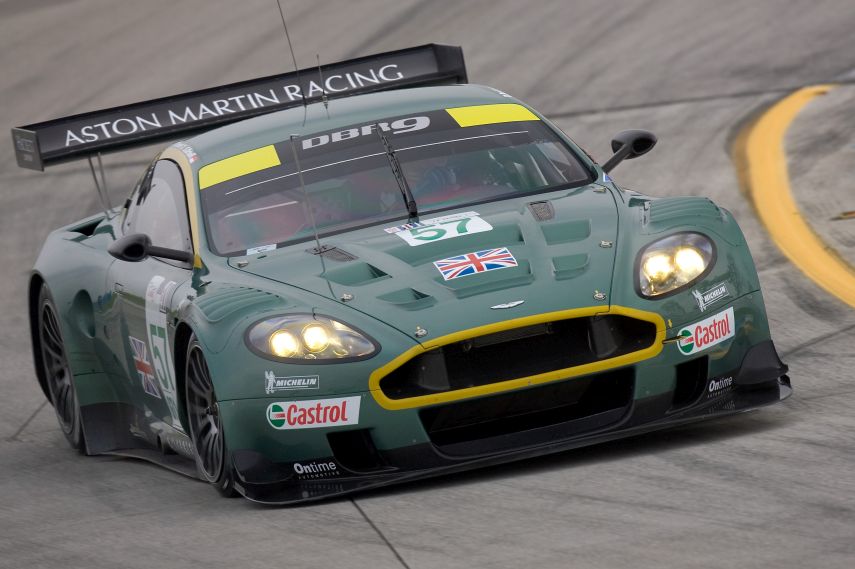
Victorious debut for Aston Martin DBR9 at 12 hours of Sebring in 2005
Victorious debut for DBR9 at Sebring
Aston Martin DBR9 had a fantastic victorious debut at 12 hours of Sebring in March 2005, the round of the American Le Mans Series. Darren Turner, David Brabham, and Stephane Ortelli took the GT1 class victory and fourth place overall in the #57 car. Later in the season, the trio was second at Petit Le Mans. In June 2005, the Le Mans comeback followed. The #59 DBR9, driven by Turner, Brabham and Stephane Sarrazin, finished third in the GT1 class, behind two Corvettes.
After a successful debuting year of the DBR9, Aston Martin Racing expanded its activities to build a variety of cars available to customer teams. In the 2006 ALMS season, Aston Martin Racing scored victories at Lime Rock Park, Miller Motorsport Park, Mosport, Petit Le Mans and Laguna Seca, but finished second behind Corvette Racing at Sebring. The team was second in the ALMS GT1 Manufacturer’s standings.
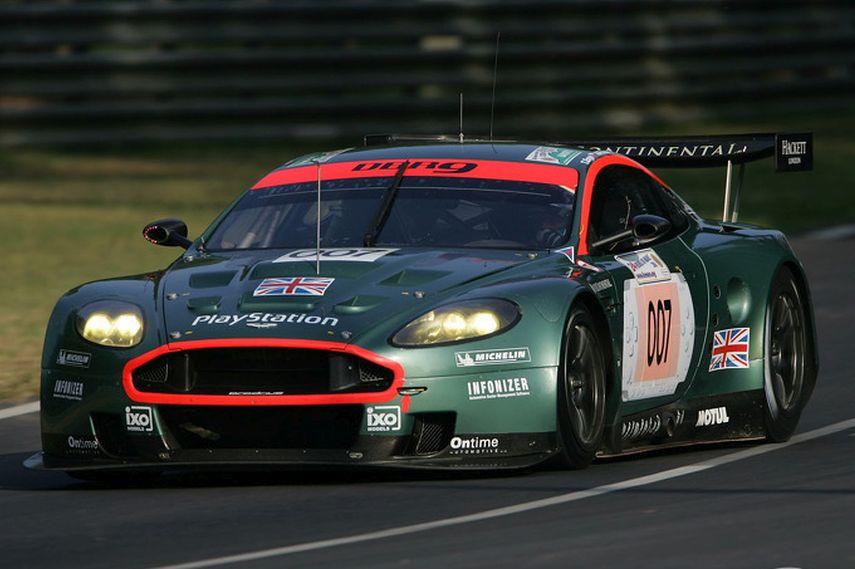
The #007 car finished second in GT1 class at 2006 24 hours of Le Mans
Podium at Le Mans, title in the Le Mans Series
At 2006 24 hours of Le Mans, Aston Martin Racing moved one step closer to the top podium spot. The #007 car, driven by Tomaš Enge, Darren Turner and Andrea Piccini, finished second in GT1 class. In the Le Mans Endurance Series, Larbre Competition took the Team’s Championship, with victories at the 1000 km of Istanbul and 1000 km of the Nürburgring. In the 2006 FIA GT Championship, few teams were using DBR9s, with Aston Martin Racing BMS and Phoenix Racing finishing second and third in the final standings.
Improved DBR9 was prepared for 2007
For the 2007 24 Hours of Le Mans, Prodrive had prepared a modified DBR9, improving performance, but also increasing driver comfort in the cockpit. Due to new regulations, the DBR9 required the installation of an air conditioning unit to prevent overstressing drivers. Prodrive went further by putting a heat-resistant white roof on all new cars to assist in keeping cockpit temperatures down.
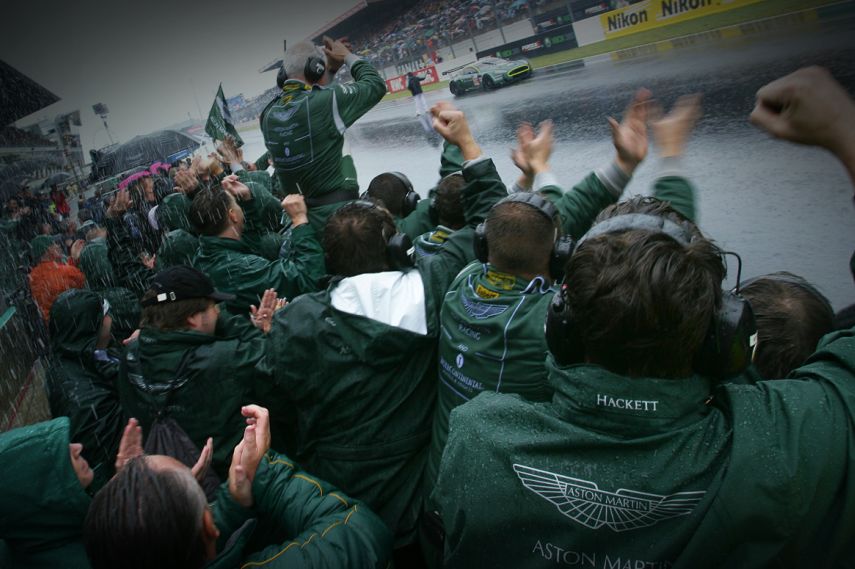
GT1 class victory at the 2007 24 hours of Le Mans
GT1 class victory at the 2007 Le Mans 24 hours
The improved car earned the first Le Mans victory for Aston Martin since its overall win in 1959. The #009 car, driven by David Brabham, Darren Turner, and Rickard Rydell took the GT1 class win by a single lap over the Corvette. The #008 DBR9, entered by Larbre, finished third in class, ahead of the #007 AMR car.
To celebrate the victory and a successful finish, with three cars in the top four, Aston Martin built a very limited edition of the DB9 called the DB9 LM (Le Mans), which featured a unique color called Sarthe Silver. Later in 2007, Aston Martin launched another limited production, the DBS road car, which has many styling cues taken from the DBR9 in conjunction with the James Bond film Casino Royale.
Second GT1 Le Mans victory in a row
In 2008, Prodrive and Aston Martin Racing prepared two Gulf Oil sponsored DBR9s for the Le Mans race. David Brabham and Darren Turner repeated the GT1 class victory with the #009 car, partnered by Antonio Garcia. The #007 car, driven by Heinz-Harald Frentzen, Andrea Piccini, and Karl Wendlinger, finished fourth in class.
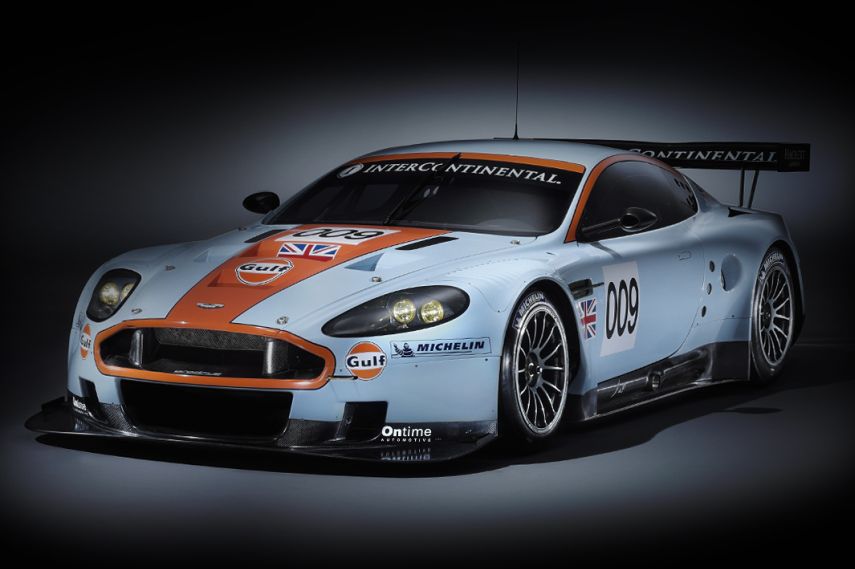
In 2008, DBR9 took a second in a row GT1 class win at Le Mans
In 2009, Aston Martin built an LMP1 prototype
While the DBR9 was the car of the choice for many private teams in 2009, including the competitive debut in the Japanese Super GT series, Aston Martin Racing chose a new direction – building of the new LMP1 prototype. The introduction of that project was the cooperation between AMR and Charouz Racing System, which entered AMR’s V12 into Lola B08/60 prototype for the 2008 Le Mans. For the 2009 Le Mans competition, Aston Martin Racing decided to build its own Lola-Aston Martin B09/60, also known as the Aston Martin DBR1-2.
The B09/60 was an evolution of the Lola B08/60. It used the 6.0-litre V12 engine from the Aston Martin DBR9 GT1 car, but with larger air restrictors, allowing an increase of 50 hp. The standard Lola gearbox was replaced by a more compact Xtrac 6-speed which was operated with paddle-shifting.
The 2009 Le Mans entry with the LMP car marked the 50th anniversary of the 1959 overall victory and Aston Martin wanted a car which can repeat that success. Even before the race, one chassis had to be written off, after Tomaš Enge had destroyed the car in a crash at the Paul Ricard test.
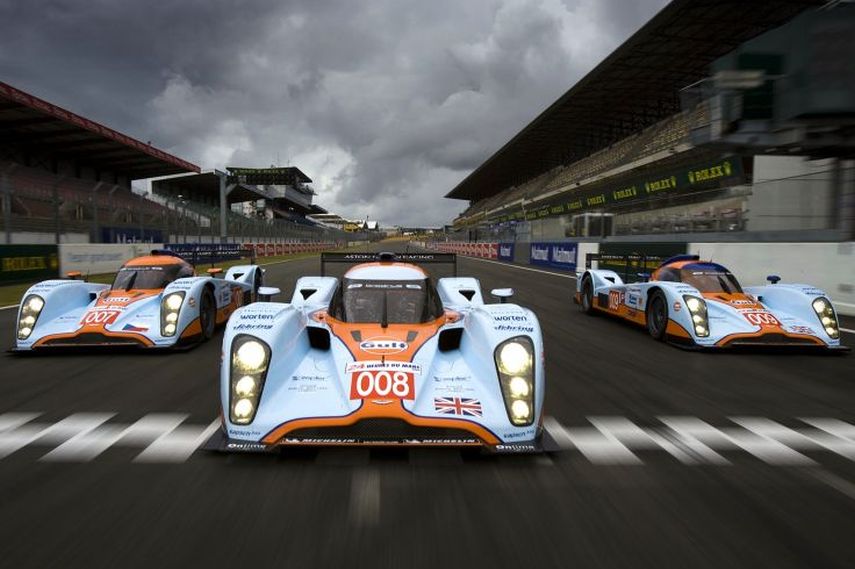
On the 50th anniversary of the 1959 Le Mans victory, Aston Martin entered the Le Mans race with three prototypes
The 007 car finished fourth at the anniversary race
The team entered the Le Mans race with two Gulf Oil liveried cars, as a reminder to the victory 50 years before, but the best place Aston Martin prototype was the #007 car under the banner of the AMR Eastern Europe. It finished fourth overall, behind the factory entries of Peugeot and Audi. The #007 was driven by Jan Charouz, Tomaš Enge, and Stefan Mücke.
The #008 AMR car, driven by Anthony Davidson, Darren Turner, and Jos Verstappen was running as high as 3rd overall in the morning until Davidson had a collision with a GT1 car. Subsequent repairs and a 5-minute stop and go penalty dropped the car to the 13th place overall. The #009 AMR car, driven by Stuart Hall, Harold Primat, and Peter Kox, retired after 252 laps.
Championship title in the Le Mans Series
In the 2009 Le Mans Series season, Aston Martin Racing trio Jan Charouz, Tomaš Enge and Stefan Mücke finished every race on the podium en route to the LMP1 championship title.

Lola-Aston Martin B09/60, also known as Aston Martin DBR1-2
In 2010, the rivals were too strong
During 2009, there were talks about Aston Martin’s comeback to the Formula One. David Richards announced that possibility, but this never materialized. Instead, Aston Martin Racing returned to Le Mans with LMP1 prototypes in 2010. The rivals were too strong, especially the Audi R15 TDI cars, so the best place Aston Martin assumed was with the #007 car in the sixth place overall. The car was driven by Harold Primat, Stefan Mücke and Adrian Fernandez. The #009 AMR car retired in the closing hours after 368 laps, while the #008 Signature-Plus car retired after 302 laps.
At the 2010 Le Mans race, the old Aston Martin DBR9 was still in use. The Young Driver AMR #3 car, driven by Tomaš Enge, Christoffer Nygaard, and Peter Kox finished 22nd overall and third in the GT1 class.
AMR-One was the new project for the 2011 season
In 2011, the B09/60 was succeeded by Aston Martin AMR-One, an LMP1 prototype powered by a 2.0-liter turbocharged straight-six petrol engine. The AMR-One was built around a light carbon fiber monocoque chassis with open top bodywork, in contrast to the closed cockpits of the rivals Peugeot 908 and Audi R18.
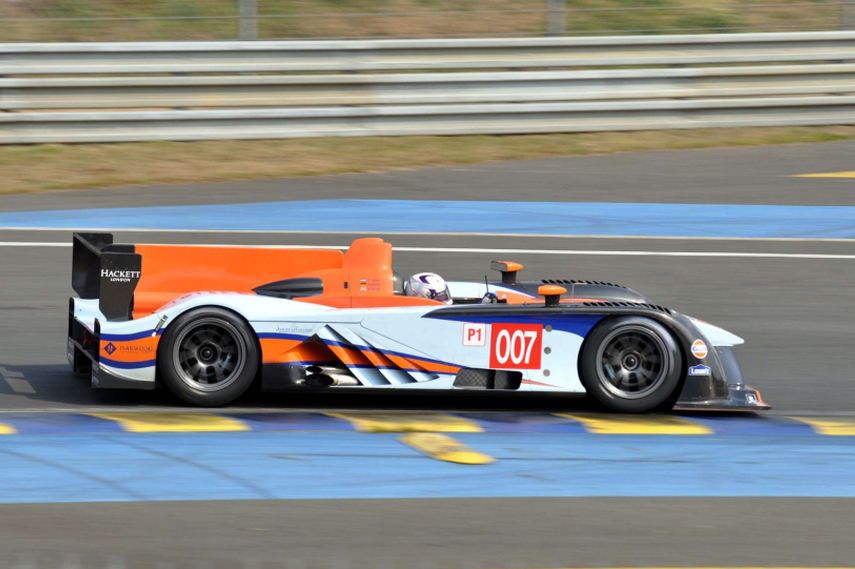
The open-cockpit AMR-One was a failure
Disastrous performance of the AMR-One
The expectations were high, but the car was running very poorly. In its first racing event, the 6 Hours of Paul Ricard, the car was plagued with mechanical issues and it was too slow compared to LMP1 rivals, even slower than some LMP2 cars.
The 2011 Le Mans race was disastrous. AMR-One qualified in the middle of the LMP2 field. The #009 car retired after only two laps, and the #007 car lasted four laps. Both vehicles completed a combined six laps at Circuit de la Sarthe. After such a shocking and disgraceful performance, the team withdrew AMR-One from the competition and raced the old B09/60 for the remainder of the season.
Two of the AMR-One chassis were later sold. The one was used for the DeltaWing project while the other was converted to the Pescarolo 03 LMP1 race-car. In January 2012, Aston Martin Racing announced that the team will focus again on the GT program.

Aston Martin DBR1-2 successfully competed in three seasons, from 2009 to 2011
AMR entered revived FIA WEC with GT cars
Aston Martin Racing entered the revived FIA World Endurance Championship with upgraded V8 Vantage GT2 car, which was in use since 2008. The new GTE version was eligible both for the LMGTE Pro and LMGTE Am classes of the FIA WEC, including the Le Mans race. The car had a 4.5-liter V8 engine.
Aston Martin Racing entered the 2012 24 hours of Le Mans with two cars, each in one GTE class. The #97 car, driven by Darren Turner, Stefan Mücke and Adrian Fernandez finished third in the GTE Pro class, behind two Ferraris. The #99 car, driven by Christoffer Nygaard, Kristian Poulsen and Allan Simonsen in the GTE Am class, retired after 31 laps.
Maiden WEC victory in Shanghai
In the 2012 FIA WEC season, Mucke and Turner scored the maiden victory in the last championship round at Shanghai International Circuit. Aston Martin Racing finished second in the LMGTE Pro Trophy standings.
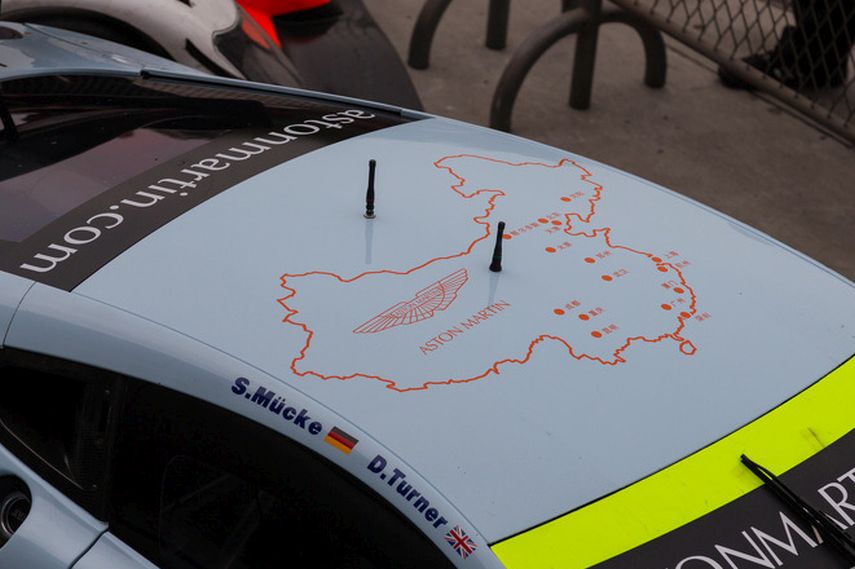
Turner and Mucke scored maiden win for Aston Martin Vantage GTE in China
AMR drivers were GTE Am champions in 2013
In 2013 FIA WEC season, Aston Martin Racing expanded its participation to five cars: three in the GTE Pro and two in the GTE Am class, numbered from #95 to #99. The most successful were #97 and #95 cars, both scoring three wins. The #97 car, driven by Stefan Mücke and Darren Turner, scored three GTE Pro class wins (Silverstone, Fuji, and Shanghai), to place the team in the second place.
The #95 car scored three wins in the GTE Am class. The #96 car added two victories and the #99 was victorious once. In total, Aston Martin collected nine class wins during the 2013 season and its drivers Jamie Campbell-Walter and Stuart Hall became the GTE Am champions.
Allan Simonsen lost his life at Le Mans
Unfortunately, the season was marred by fatal accident of the driver Allan Simonsen at the Le Mans race. After ten minutes of racing in the #95 Vantage GTE, he crashed heavily into the barrier at Tertre Rouge. Simonsen was transported to the hospital where he died from injuries.
Other drivers continued the race and #97 car reached the podium in the GTE Pro class. Darren Turner, Peter Dumbreck, and Stefan Mücke finished third, behind two Porsches. In the GTE Am class, the #96 Aston Martin finished sixth.
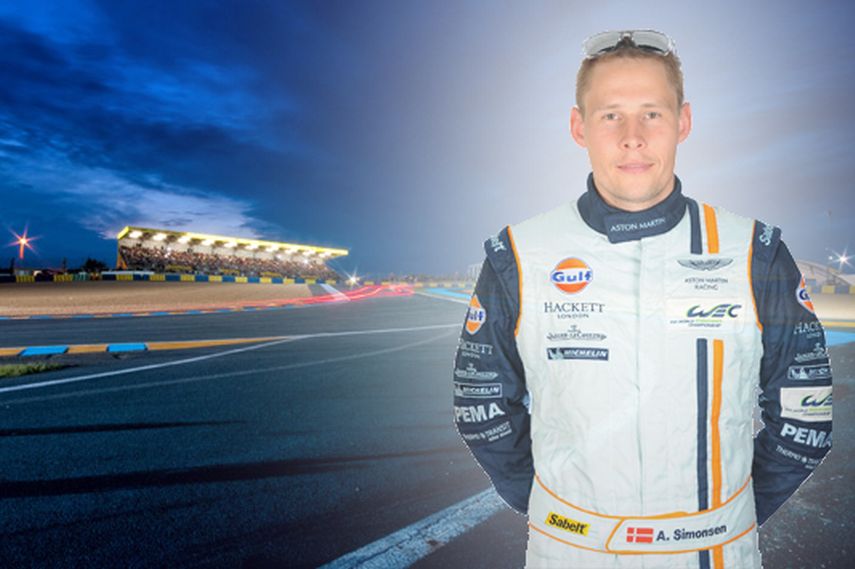
Allan Simonsen lost his life at 2013 Le Mans race
One more GTE Am championship title in 2014
In the 2014 FIA WEC season, Aston Martin Racing participated with four cars and again scored nine class wins. The most successful was the all-Danish crew in the #95 Vantage, which took the championship title in the GTE Am class with four wins, including Le Mans 24-hour race. The winning drivers were Kristian Poulsen and David Heinemeier Hansson. At Le Mans and other three victorious races, their co-driver was Nicki Thiim. Thiim missed three races, so he didn’t win the championship.
Only one victory in the 2015 FIA WEC season
In the 2015 FIA WEC season, Aston Martin didn’t acquire any titles, competing again with five cars in GTE classes. The most successful crew was in the #98 car. Paul Dalla Lana, Mathias Lauda, and Pedro Lamy won three races and finished third in the GTE Am class standings. The only other AMR crew which scored victory was the #99 at Spa. The drivers were Fernando Rees, Alex MacDowall, and Richie Stanaway. At 24 hours of Le Mans, the best-placed crew was in the #95 Aston Martin, with fourth place in the GTE Pro class.
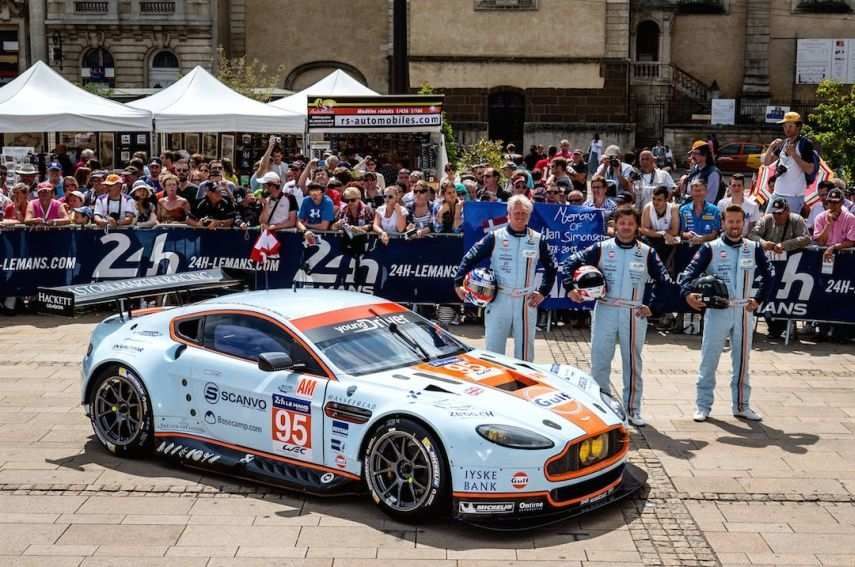
In 2014, the #95 crew won both the Le Mans race and the GTE Am class championship
2017 – GTE Pro Le Mans wins and GTE Am FIA WEC title
At the 2016 24 hours of Le Mans, Aston Martin Racing had no reasons to celebrate: the best-placed crew in the GTE Pro class was in the sixth place, while in the GTE Am class they finished in the seventh place. However, at the end of the season Aston Martin celebrated the title in GT class for Nicki Thiim and Marco Sorensen.
Next year, the final result for the team was even better. The #97 Aston Martin Vantage, driven by Jonny Adam, Darren Turner and Daniel Serra, won the GT class at Le Mans 24 Hours. Nicki Thiim and Marco Sorensen added one more GTE Pro win in the #95 car to finish sixth in the final points. In GTE Am category, the #98 Aston Martin won the championship title, driven by Paul Dalla Lana, Pedro Lamy and Mathias Lauda.

Aston Martin Racing is using two new cars in the 2018-2019 FIA WEC season
New car for the 2018-2019 FIA WEC super-season
A new car has been introduced for the 2018-2019 FIA WEC supers-season – the Aston Martin Vantage AMR. The team continued to compete in the GTE Pro class with two crews and in the GTE Am class with one crew. The first win of the new car came in the fifth round at Shanghai where Nicki Thiim and Marco Sorensen won the race in the #95 car. In the GTE Am class, the defending champions in the #98 opened a season with a victory at Spa-Francorchamps.
At 2018 Le Mans 24 Hours, the #95 was eighth in the GTE Pro class, five places ahead of the #97 car, while the #98 car crashed early in the race.
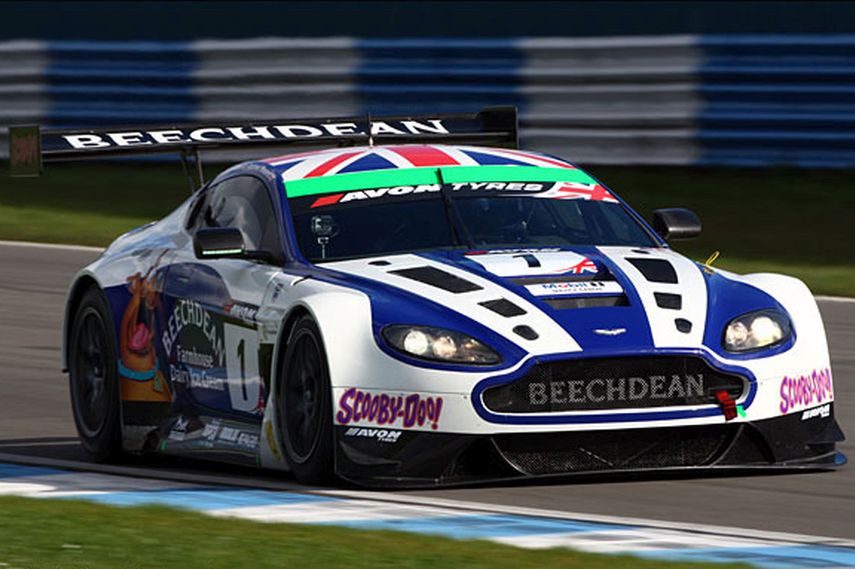
Beechdean is one of the most successful AMR customer team
Streak of titles on the home ground
While Aston Martin Racing had ups and downs, many customer teams all over the world are also collecting triumphs with Aston Martin GT cars prepared by AMR and Prodrive, both with V12 Vantage GT3 cars and V8 Vantage GT4 versions.
In the Aston Martin’s homeland, the Aston Martin race-cars dominated in the British GT Championship for the last few years. Most recently, in 2018, TF Sport AMR took the Teams’ title while Jonny Adam and Flick Haigh captured Drivers’ title with Optimum Motorsports Vantage GT3. In 2016, Jonny Adam and Derek Johnson became champions in TF Sport’s Aston Martin Vantage.
In 2015, both titles in the GT3 and GT4 classes were won by Aston Martin’s customer team Beechdean AMR. Beechdean principal Andrew Howard was also the GT3 champion in 2013, while his drivers Ross Wylie and Jake Giddings won the GT4 title in 2014.
There are lots of other examples in other national and international racing series and championships which prove that Aston Martin Racing, Prodrive, and their partners are on the right way to follow the original idea of the Aston Martin founders Lionel Martin and Robert Bamford, who started the company in 1913 with a desire to build distinctive, high-quality sports and racing cars.
Video : Aston Martin Racing – hand crafted race-cars
Photos: astonmartin.com, gettyimages.com, nobraking.com, wallpaperup.com, dailysportscar.com.


